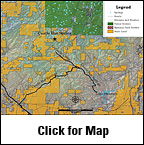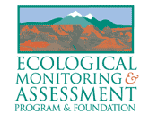Castle Hot Springs
Introduction
 Castle Hot Springs, sometimes referred to as the “grand dowager” of Arizona resorts, is located just 55 miles northwest of downtown Phoenix in a valley surrounded by the rocky cliffs and crags of the Bradshaw Mountains. The site enjoys a rich and lengthy history stretching back to the pre-settlement Apaches who attributed healing powers to the hot, clear water that poured out from the canyon rock. Castle Hot Springs served as the first territorial capital of Arizona as well as a retreat for wealthy businessmen, politicians, and even presidents. These waters were advertised as a cure for a long list of ailments and are the source of a verdant oasis in a landscape dominated by cactus and desert scrub.
Castle Hot Springs, sometimes referred to as the “grand dowager” of Arizona resorts, is located just 55 miles northwest of downtown Phoenix in a valley surrounded by the rocky cliffs and crags of the Bradshaw Mountains. The site enjoys a rich and lengthy history stretching back to the pre-settlement Apaches who attributed healing powers to the hot, clear water that poured out from the canyon rock. Castle Hot Springs served as the first territorial capital of Arizona as well as a retreat for wealthy businessmen, politicians, and even presidents. These waters were advertised as a cure for a long list of ailments and are the source of a verdant oasis in a landscape dominated by cactus and desert scrub.
Castle Hot Springs was closed for business following a fire that destroyed the main building. Several structures, the lush lawn, and its rows of hundred-year-old palm trees are now maintained by caretakers and can be viewed from the road. To view the resort, take the Lake Pleasant Road off Highway 74 towards Lake Pleasant entrance and go left at the fork. Castle Hot Springs Road is unpaved and is rugged driving for the next 12 miles. The drive itself is quite scenic, dotted with saguaros and, with good timing, lined by a carpet of desert wildflowers.
Human History
Historically, the waters were known by the Yavapai and Apaches as medicinal. Once the Apaches were gone, white settlers started accessing the waters. In the late nineteenth century, a surge in tuberculosis patients moved to Arizona. The site soon developed into a hotel for this clientele.During its time as the territorial winter capital, Castle Hot Springs housed the governor and a local jail. It has been reported that the building’s balcony served as a convenient site for hangings. The resort attracted many of America's wealthiest and most well-known families, including the Rockefellers, Wrigleys, Cabots, and Carnegies. Western author Zane Grey also stayed here, as did members of the Roosevelt family. Many were regular visitors, using the resort as an escape from the harsh cold of East Coast winters.
During World War II, Castle Hot Springs was leased to the military to house recuperating pilots, President John F. Kennedy among them. This distinction earned Castle Hot Springs a special dispensation, allowing the American flag to be flown 24 hours a day on nearby Salvation Peak. Today the flag is maintained by the Boy Scouts of America.
Following closure in 1976 after a devastating fire, Castle Hot Springs has since changed hands many times. Arizona State University used the site as a conference center until 1987 when it was sold to a series of private owners. In 1996, another fire destroyed a cottage once occupied by the Wrigleys. The two remaining buildings, pool, and golf course are now maintained by caretakers on the property.
Hydrology
The hot springs are fed by an enormous cistern created by the displacement of tertiary volcanic rock, tens of thousands of years ago. Each day, this underground reservoir produces 200,000 gallons of water at 122 degrees Fahrenheit—the hottest temperature known for a spring which is not volcanically active. The waterfall emerges from a crack in the rock wall, supplying Castle Creek and its three deep pools with water that is quite pure, odorless, and crystal clear. Its superb quality indicates a source depth of 7,000 to 10,000 feet.Ecological Importance
A lush patchwork of native and introduced vegetation can be found here. Hedgehog cactus and ocotillo bloom alongside manicured palms and fruit trees, including oranges, grapefruits, and figs. In past years, the U.S. Fish and Wildlife Service has made attempts to reintroduce the federally endangered Gila topminnow to Castle Creek.The hot springs and associated creek also provide critical habitat to populations of toads and frogs. Flying insects that congregate over these waters provide food for nearby colonies of bats, including Myotis lucifugus occultus, the only subspecies found in Arizona.
Contributing Writers
Carl Olson and Kim Whitley.
Photo © Kim Whitley
Bibliography
- Castle Hot Springs Company. 1910. Castle Hot Springs, Arizona; the land of perpetual sunshine. New York: Norman Pierce Co.
- Castle Hot Springs Hotel. 1924. Castle Hot Springs, Arizona. Hot Springs, Ariz: Castle Hot Springs Hotel.
- Clement, Judith A. 1989. Castle Hot Springs Road: self guided tour #1. Desert Enterprises Press.
- Weedman, David A. 1998. Gila Topminnow, Poeciliopsis occidentalis occidentalis, Revised Recovery Plan. Arizona Game and Fish Department.






